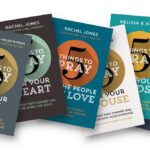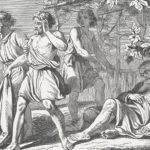Friends are somewhere between amazed and aghast when I tell them that I run three women’s Bible study groups each week. The truth is only one of them is a classic Bible study group using a prepared study guide. The other two are reading groups.
These groups came about because I found there were quite a few women in our church who were reluctant to read the Bible, let alone study it. Based on the principles in David Helm’s very helpful book One-to-One Bible Reading: A Simple Guide for Every Christian, I set up one group and then another. Instead of doing one-to-one Bible reading, it was six- (or seven or eight) to-one Bible reading.
What a Reading Group Looks Like
We choose a book of the Bible and simply read—one chapter at a time or maybe one chunk of a chapter at a time. Read. Look up. Discuss. I initiate discussion with the question “What did you observe?” or “What jumped out at you?” Discussion might move on to the question, “What does this bit mean?” thrown in my direction. Occasionally we work through the eminently helpful questions: “What do we learn about people?”, “What do we learn about God/Jesus?” and “What does that mean for us?”
And then it’s heads down and read the next bit. We typically get through two or three chapters per session.
Preparation
I generally don’t do much preparation for these groups. In the early days, with intention, I did no preparation. I wanted to model that sometimes we read parts of the Bible and it’s very hard to understand, and I also don’t know all the answers. We can still read on and maybe next time we come across this passage we might understand it a bit more. It’s okay to press on.
Reading in Context
Alongside reading, I make sure that every year or two we spend a session going through an overview of the Bible. For my groups this means reviewing the contents page to discuss the layout of the Bible and the different genres of the Old and New Testament. Then we work the ‘Outline of Old Testament History’ from Graeme Goldsworthy’s Gospel and Kingdom as a roadmap. Every time we start a new book of the Bible we make sure we know what genre we’re dealing with and where we are on the roadmap.
We also make big use of maps of ancient Israel. Nearly every time a location is mentioned, we check out the location. Having a grasp of the local geography brings Bible reading alive.
Guided Reading Plans
Over many years my group members have grown in confidence. We’ve read through large amounts of the Bible. Most are now reading the Bible for themselves using a Bible reading plan and getting through the whole Bible in a year.
In more recent times I have upped the ante just a bit by taking them through mini-reading plans. This started quite simply by undertaking to read the bookends: Genesis and Revelation. Prior to Christmas I suggest we read the Christmas narratives and the Easter narratives, because Easter informs Christmas and Christmas informs Easter.
One time, before reading Peter’s letters we read through every encounter involving Peter in the gospels and Acts. We got to know the man Peter—there is so much more to him than the two-dimensional “impulsive” caricature—and so better understood the letters he wrote near the end of his life and ministry.
Similarly, before reading Joshua we looked up every reference to Joshua prior to his book and so got to know the man. Did you know, for example, that he was with or at least very nearby Moses when Moses received the Ten Commandments (Exodus 24:13)? Or that when God met with Moses in the tent of meeting that Joshua was there too? Moses would come and go from that tent, but Joshua stayed (Exodus 33:7–11). Joshua has a huge backstory.
In our read-through of Acts, when we met James in chapter 15 we paused and read his letter. When Paul visited Thessalonica or Philippi or Ephesus or Corinth, we put our bookmarks in Acts and read the relevant epistle. This wasn’t a chronological read-through of the letters, but it meant we knew them better, because we understood the flavour of the place and the people to whom each letter was written.
When we read Ezra and Nehemiah, we made sure to stop and read Haggai, Zechariah and Malachi, the associated minor prophets.
Always with an atlas or maps at the ready, and always with reference to the Bible overview.
Growing in Confidence to Read the Word
Over the years the women who have met with me on this several-to-one basis have grown in their understanding of the Bible. We still ask the same questions after each chapter. I still often go in unprepared by design and continue to model that it is okay to not know or understand everything, and that we can still read on. And I have observed that after a few years of meeting together to read the Bible once per week for an hour or so, the members of my groups have far more capacity to make sense of this sometimes tricky but always life-giving book. More and more, they can see that every page points to Jesus.















